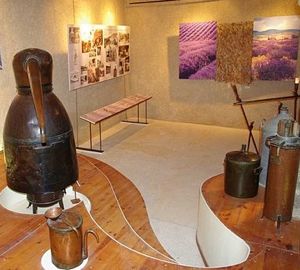- Home
- Guide for Essential Oil Use
- Essential Oil Distiller
As an affiliate for Bookshop, Amazon, and other programs, I may earn a small commission for products purchased through links. This doesn't affect the price you pay. Privacy policy and disclosures.
Search this site:
Using an Essential Oil Distiller At Home
An essential oil distiller extracts essential oil from plant material.
 Antique essential oil distiller in a museum
Antique essential oil distiller in a museumHere's the basic process of steam distillation of essential oils:
- Plant material sits in a basket above a steam generator (or boiler).
- The boiler heats water and the vapor rises through the plant material. The steam releases the plant's volatile oils and collects them.
- The steam-oil mixture moves into a condenser. The mixture condenses into a liquid combination of water (hydrosol) and a layer of essential oils.
- A separator splits up the essential oil and the hydrosol.
In a commercial essential oil distillery, a large distiller can process
hundreds of pounds of plant material. But if you want to make essential
oils at home, you can buy an essential oil distillation kit.
More About Essential Oil Extraction
Usually, essential oils are distilled from fresh plant materials, but sometimes the plant is first dried. Dense or thick material, such as roots and seeds, are crushed or chipped before distillation.
If you want to distill an essential oil, you must first know what part of the plant to use. Leaves? Flowers? Roots? Seeds? Twigs or wood chips? Research an essential oil to learn what part of the plant to use.
The amount of essential oil produced during distillation depends on four main factors. The most important is the type and quality of the plant material. The other three are distillation time, temperature in the distiller, and the operating pressure of the distiller.
Other details also affect yield, such as plant harvest time (time of day and year), climate conditions, and the amount of volatile oil each plant contains. The typical yield of essential oil from plants is between 0.005 and 10%. For example, plants that produce a relatively high percentage of oil (such as sage, thyme, and rosemary), require about 500 pounds of plant material to produce 32 ounces of oil.
In other words, if you plan to distill rosemary, expect to use about 15 pounds of rosemary leaves to get one ounce of oil. For a low-yield oil, such as rose, expect to use many more pounds for one ounce of oil.
Source: Aromatherapy: A Complete Guide to the Healing Art
Here are two books with instructions on home distillation of essential oils: The Essential Oil Maker's Handbook and Tabletop Distilling.
Other Essential Oil Distiller Sellers
Companies selling specific equipment for distilling essential oils: Olympic Distillers and Distillation Supplies.
Four companies promoting their moonshine stills for essential oil extraction:
- Brewhaus — Distill Essential Oils With a Moonshine Still
- Whiskey Still Pro — A Beginner’s Guide to Distilling Essential Oils at Home
- Clawhammer Supply — How To Make Essential Oils Using Steam Distillation
Buy essential oils: Aromatics International or Rocky Mountain Essential Oils.
Distiller Photo: © Service communication du Conseil général des Alpes de Haute-Provence (Own work) [CC BY-SA 3.0 via Wikimedia Commons.



